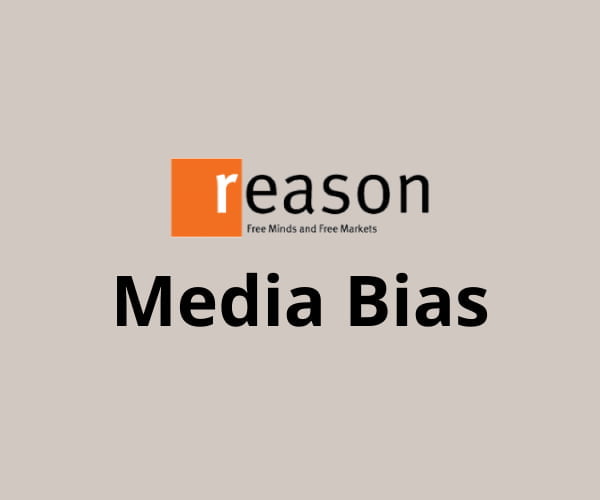
Reason, “Free Minds and Free Markets,” is a U.S. monthly magazine for public policy and general interest. Founded and released in 1968, the magazine is currently owned by the Reason Foundation, covering politics, culture, and ideas using news, analysis, commentary, and reviews.
Pew Research cites that 78% of Americans read at least occasionally to keep up with current events– as such, this American news source will be investigated. This article will analyze the magazine’s coverage and editorial decisions to determine whether or not the information Americans are reading to keep up with current events has a political bias or not. Through our analysis, we hope to provide a comprehensive answer to whether the Reason is biased, as well as determining the factors that contribute to media bias as well.
How Does Biasly Rate News Sources?
Biasly’s algorithms produce bias ratings to help provide multiple perspectives on given articles. Biasly has analyzed 200,000+ news articles from more than 3,200 news sources through our A.I. technology and team of political analysts to find the most factual, unbiased news stories.
Biasly determines the degree of political bias in news sources by using Biasly’s Bias Meter Rating, in which Biasly’s team analyzes media sources’ reliability and bias and produces three scores, a Reliability Score that measures the accuracy of media sources; an A.I. Bias Score, evaluated by A.I.; and an Analyst Bias Score evaluated by political analysts. These scores are rated based on seven rating metrics including Tone, Tendency, Diction, Author Check, Selection/Omission, Expediency Bias, and Accuracy. These metrics help our analysts to determine the political attitude of the article.
Our A.I. a machine-learning system employs natural language processing and entity-specific sentiment analysis to examine individual articles and determine their bias levels. By analyzing the key terms in an article such as policies, bias phrases, political terminologies, politicians, and their nicknames, the algorithms can rate the attitude of the text. Bias scores range from -100% and 100%, with higher negative scores being more liberal and higher positive scores being more conservative, and 0% being neutral.
Is The Reason Politically Biased?
The creative concept and ideas behind the Reason magazine are particularly interesting from a consumer perspective:
“As a magazine of free minds and free markets, Reason exists outside of the left/right echo chamber. Our goal is to deliver fresh, unbiased information and insights to our readers, viewers and listeners every day” – About Reason
Consider also that Reason is the “nation’s leading libertarian magazine.” Pew Research states that libertarianism has been gaining significant popularity– take a look at the chart below for a demographic breakdown of the 11% of Americans who describe themselves as a libertarian:

Source: Pew Research
As such, taking a look into Biasly’s analysis of its bias and taking a deep-dive into some articles will give us a holistic perspective of the Reason.
Biasly’s rating for Reason is based on two scores, one derived from computer algorithms based on A.I., and one from its analysts. Biasly rated Reason with a Computer bias score of Moderately Conservative and an Analyst bias score of Moderately Conservative, which means that overall the source will provide political coverage from a slight American conservative political perspective. Analyst scores are based on an average of at least 15 articles with each article being reviewed by a liberal, moderate and conservative analyst. The more articles that are rated by Biasly’s analysts team for a specific source indicates a more accurate analyst score. So, as Biasly rates more articles, the scores will become more accurate. Praise for conservative politicians and policies and dislike for liberal policies and politicians contribute to this rating. Last, Biasly’s scores closely align with analysis from other third-party bias research agencies.
The remainder of this article will talk about ways to identify bias in order to separate opinions from fact. This altogether will increase our media understanding and help us to become a more informed consumer of news.
Before we begin, we need to discuss bias. Bias is a natural function of humans, and we can express it both consciously and unconsciously. Bias is one of the most fundamental forms of pattern recognition in humans. This isn’t to lower the bar and say that “all things are biased,” but to explain the process in which we may come to trust certain news organizations that display patterns of coverage.
On the media’s part, there is an incentive to retain audiences, encourage them to purchase subscriptions, and rate products positively. Bias is a two-way street, people want to see news stories about things they care about, and the media needs viewers to continue their operations. This creates a positive feedback loop that influences what stories are covered and from what perspective. This also explains the actions of more liberal news organizations.
Analysis of Bias in The Reason Online Articles
When determining bias, metrics include Tone, Author, Diction (among others), these will be the primary metrics that we will focus on below. Tone is the attitude of the writing and is similar, but distinct from diction which are the specific word choices of a writer. Last, the Author metric refers to the author of the articles and their demonstrated political stances determined through past articles and personal social media posts.
The first article we’ll take a look at is called “Deluded Republicans and Smug Democrats Offer Little Hope for People Who Want To Be Left Alone” and has been rated “Somewhat Conservative” on Biasly’s Bias Meter. Although the author addresses both democrats and republicans with negativity, there is a slight-right leaning tone in the article which would explain Biasly’s rating.
Further, the tone of the article is rather pessimistic about both sides of the political spectrum, addressing both sides and their respective flaws and scandals. Yet, there is slightly more negativity towards the Biden administration, including the following statements:
“Unfortunately, Biden and Democrats pretend that protecting democracy requires concentration power and muzzling dissent.”
“Targeting speech hostile to the administration is especially dangerous as Biden pursues an ambitious agenda, including massive spending laden with payoffs to allies.”
As a result, despite the author’s attempt to remain neutral in its tone, this isn’t the case. Next, the diction, while not very extreme, clearly asserts the author’s negativity towards the government, labeling Republicans as “cultists” and Democrats as “totalitarians.”
Last, author J.D. Tuccile’s personal Twitter account as well as other articles demonstrate his personal stance, which corresponds with the right-leaning analysis of the article above. Tuccile’s Twitter confirms that he believes there’s good reason to investigate a Biden impeachment, and that the government is spending way too much money. Moreover, Tuccile’s previous articles on Reason also show his personal stance, as they are titled:
- “Biden, the ‘Most Pro-Union President,’ Reaps What He Shows,”
- “There’s Plenty of Evidence of Corruption Around Biden,”
Overall, while the article strives for objectivity and does touch on flaws on both sides of the political spectrum, ultimately there is a slight-right leaning bias present in the article. All of this suggests that despite some neutral elements, our analysis of this article aligns with our overall analysis and ranking of media bias found in Reason magazine.
Although this article falls to the right on the political spectrum, article bias differs between topics and authors, even though they come from the same source. Ultimately, this demonstrates the importance of looking for signs of media bias, with factors including tone, diction, author, and omission bias in any articles that you read.
For example, another article from The Reason that demonstrates little media bias is titled “An $86 Billion Moral Hazard.” Biasly’s rating is “Center ” for this article, as its content is very cut and dry and leaves out negative notions of politicians and their policies. Moreover, the article avoids emotionally loaded language and sticks to using neutral terms:
“The American Rescue Plan Act creates a new federal grant program to support multi-employer pension funds. There are more than 1,400 of these retirement plans, which are jointly funded by unions and the private companies that contract with them through collective bargaining agreements.”
There is small mention of Democrats and Republicans in the article, but it is entirely objective and speaks to facts without emotionally loaded language:
“Democrats in Congress have been seeking federal aid for these retirement plans for years, while Republicans have been pushing for reforms in exchange for new loan or grant programs to prop up the pension system.”
In this article, mention of specific political sides does not influence the content or tone of the article.
These articles are only a small representation of all of the Reason’s content, but they indicate that the outlet does have opinion in their writing– this further underscores the importance of knowing how to differentiate between subjective writing and genuine reporting.
Who Owns The Reason?
Reason is published by Reason Foundation, which is a nonprofit education and research organization. The foundation was created in 1978, while the magazine was first published nearly ten years prior. According to the Foundation:
“Reason and Reason.com provide a fresh alternative to right-wing and left-wing outlets by making a principled case for liberty and individual choice in all areas of human activity.”
Founder Robert Poole served as past president of the Foundation, however pictured below is David Knott, who has served as Reason Foundation’s president since 2001:

Source: Reason Foundation
How to Evaluate and Uncover Bias
It can often be difficult to tell if the news you watch is biased. If you have settled on a news channel, it’s usually because you trust the information you are gaining. Unfortunately, many trust the information they are hearing because it confirms what they already believe. This is referred to as “confirmation bias.” It is important to challenge your beliefs and get third-party verification that what you are hearing is the full story. This is why we recommend using Biasly to compare different news stories side-by-side using our bias ratings to figure out what both sides think of a political issue.
Although Biasly gave Reason a Moderately Conservative bias score, recall that bias varies between articles and that Reason does not explicitly publish conservative writing pieces. Additionally, some article types will inherently have more or less bias than others– general news articles are typically less biased than ones with opinions. Lastly, every article you read will have some form of bias (maybe even to the smallest degree), so it is critical to use resources such as Biasly’s News Check to determine the bias of what you read.






















